
Geohintonia mexicana f. cristata Photo by: Valentino Vallicelli
Thin (left) and wide (right) crested forms.
Origin and Habitat: Garden origin (Nursery produced cultivar). The odd crested forms are extremely rare and may appear both on seedling batches in a very small percentage and in habitat too.
Synonyms:
See all synonyms of Geohintonia mexicana
Description: Geohintonia is a monospecific genus of unique appearance discovered in 1992.
This plant sometimes produces beautiful fan shaped crests of variable appearance and size (depending on clones), the more common type has thin ribs and colourful brown-orangish dark bodies and is almost always seen grafted onto columnar shaped cacti, while the thick greyish-green bodied forms (usually on their own roots and raised from seeds) are very rare and priced for their extraordinary beauty by impassioned.
Stems: The standard Geohintonia mexicana is a usually solitary, dark green/brown dwarf cactus covered by a glaucous/grey pruina, globose becoming slowly columnar, up to 10 cm or more, 10 cm in diameter with a woolly apex.
Ribs: Numerous (18-20) and well distinct.
Areoles: Large, discrete, at first with long wool, later nearly naked.
Spines: Few, very short (3 to 15 mm), triangular, curved, flatened and corky, soon papery a brittle deciduous. Easily detached from the base.
Flowers: 2 x2-4 cm, rich pink to magenta and open during the day; they are born in on top of the plant. Pericarpel and lower part of the tube naked, white. Upper part of the tube with small acute scale, with densely hairy axil bearing 1 cm long white bristles. Stigma 5-6 mm long, yellowish white.
Blooming season: Flowers intermittently throughout the warm months from spring to autumn.
Fruits: Hidden in apical wool, ovoidal (approx 9x4-5 mm), thin walled, pale, drying and breaking off below the middle.
Seeds: Oval, 1,2x0,7 mm, black brown, shiny, relief flat to low-domed. The hilum is large, basal and superficial.
Subspecies, varieties, forms and cultivars of plants belonging to the Geohintonia mexicana group
 Geohintonia mexicana Glass & W.A.Fitz Maur.: It is a strongly ribbed cactus of unique appearance. The stem is dark green/brown covered by a glaucous/grey pruina, globose, becoming slowly columnar, up to 10 cm or more, 10 cm in diameter with a woolly apex.
Geohintonia mexicana Glass & W.A.Fitz Maur.: It is a strongly ribbed cactus of unique appearance. The stem is dark green/brown covered by a glaucous/grey pruina, globose, becoming slowly columnar, up to 10 cm or more, 10 cm in diameter with a woolly apex. Geohintonia mexicana f. cristata hort.: Fan shaped crests of variable appearance and size (depending on clones), the more common type has thin ribs and colourful brown-orangish dark bodies, while the thick greyish-green bodied forms (usually by seeds) are very rare.
Geohintonia mexicana f. cristata hort.: Fan shaped crests of variable appearance and size (depending on clones), the more common type has thin ribs and colourful brown-orangish dark bodies, while the thick greyish-green bodied forms (usually by seeds) are very rare.
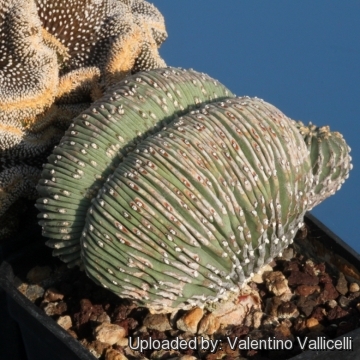 Geohintonia mexicana f. cristata Photo by: Valentino Vallicelli
Geohintonia mexicana f. cristata Photo by: Valentino Vallicelli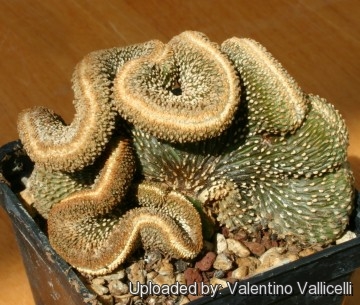 - A beautiful crest grafted on a very short Opuntia compressa stock. Photo by: Valentino Vallicelli
- A beautiful crest grafted on a very short Opuntia compressa stock. Photo by: Valentino Vallicelli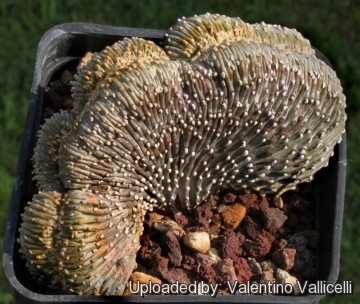 Geohintonia mexicana f. cristata Photo by: Valentino Vallicelli
Geohintonia mexicana f. cristata Photo by: Valentino Vallicelli Geohintonia mexicana f. cristata Photo by: Valentino Vallicelli
Geohintonia mexicana f. cristata Photo by: Valentino Vallicelli Geohintonia mexicana f. cristata Photo by: Cactus Art
Geohintonia mexicana f. cristata Photo by: Cactus Art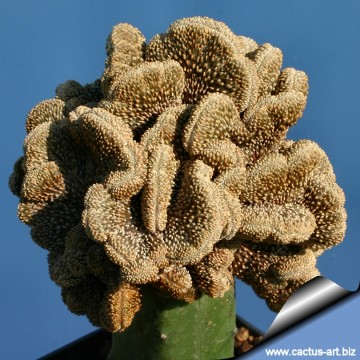 Geohintonia mexicana f. cristata Photo by: Cactus Art
Geohintonia mexicana f. cristata Photo by: Cactus Art Geohintonia mexicana f. cristata Photo by: Valentino Vallicelli
Geohintonia mexicana f. cristata Photo by: Valentino Vallicelli Geohintonia mexicana f. cristata Photo by: Valentino Vallicelli
Geohintonia mexicana f. cristata Photo by: Valentino VallicelliCultivation and Propagation: Although regarded as a choice and difficult plant in cultivation it is relatively easy to grow, but very slow growing. It is often seen as a grafted plant but grows very well on its own roots too. Needs a very well drained mineral substratum with little organic matter (peat, humus). These plant tolerate extremely bright situations but are likely to suffer from sun scorch or stunted growth if over exposed to direct sunlight during the hottest part of the day in summer. Waterings should be rather infrequent, to keep the plant flat shaped and not become excessively elongated and unnatural in appearance. Use Water sparingly from March till October and keep perfectly dry in winter, or when night temperatures remain below 10° C (but some people give this plant a light monthly watering to prevent the drying and shedding of the lower tubercles.) It is hardy to -4°C (or less) for a short period. In the rest period no high atmospheric humidity!! Ensure a good ventilation.
Propagation: : Propagation: Gafting and cuttings.
Your Photos
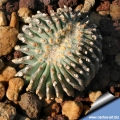
by Cactus Art

by Valentino Vallicelli

by Cactus Art

by Cactus Art
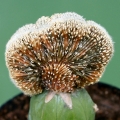
by Valentino Vallicelli























